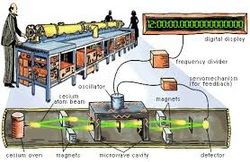Timekeeping is an omnipresent component of human experience, yet the mechanisms underpinning it reveal a fascinating realm of scientific exploration. At the forefront of precision timekeeping, atomic clocks represent a triumph of modern technology and physics. In contrast, traditional alarm clocks have served humanity’s temporal needs for centuries, but how deep is the chasm that separates these two instruments? This examination will delve into the unique functionalities, underlying principles, and applications of atomic clocks versus alarm clocks, ultimately elucidating the reasons atomic clocks outshine their mechanical counterparts.
The crux of understanding timepieces lies in their foundational mechanics. Alarm clocks, grounded in simple mechanical processes, often employ a spring-driven mechanism to impart motion to the clock hands. Their intricacies are largely mechanical, swayed by friction and the gradual wear of components. In stark contrast, atomic clocks harness the natural oscillations of atoms—specifically, the vibrations of cesium or rubidium atoms. The oscillation frequency within these atoms is extraordinarily stable, leading to what can only be described as the epitome of precision in timekeeping.
Consider the atom. At its core, it embodies the essence of time measurement. The cesium atomic clock relies on the principle that cesium-133 atoms transition between two energy states at a consistent frequency: 9,192,631,770 times per second. This remarkable property provides the basis for defining the second in the SI unit system. Can an alarm clock, with its reliance on springs and gears, even begin to compete with such a definition based on the fundamental laws of quantum mechanics?
The augmented precision of atomic clocks poses a question: Why does such meticulousness matter? In an age defined by rapid technological advancement and intricate global interactions, accurate timekeeping becomes critical for synchronization across various networks. Time is an invaluable resource in industries such as telecommunications, satellite navigation, and even financial markets, where mere milliseconds can dictate success or failure. Atomic clocks stand at the epicenter of these operations. The Global Positioning System (GPS), for instance, relies on a network of atomic clocks that ensure positional accuracy is maintained to within a few centimeters, something that conventional alarm clocks could only dream of achieving.
As we delve deeper into the realm of functionality, one can observe that atomic clocks do not merely outperform alarm clocks in accuracy; they also transcend their simpler counterparts in terms of longevity and reliability. Alarm clocks, particularly those of the analog variety, often succumb to the vagaries of time and usage. The wear and tear evident in such devices typically calls for periodic resetting and replacement of batteries or mechanical components. Alternatively, atomic clocks can function with astonishing consistency over extended periods, with adjustments made only once every few million years. The comparison starkly illuminates the atomic clock’s intrinsic superiority.
Yet, with advanced technology comes an array of concerns. Utilizing atomic clocks necessitates a comprehension of quantum physics that may seem daunting to the layperson. This complexity could present a barrier for widespread understanding and implementation. Alarm clocks, with their straightforward interfaces and operational simplicity, remain favorable for the general populace. Are we, then, to concede that while atomic clocks are unparalleled in precision, the mundane alarm clock preserves an irreplaceable place in everyday life?
Furthermore, one must examine the economic implications of these timekeeping devices. Atomic clocks, while offering exquisite precision, come with a hefty price tag. The initial investment in developing and maintaining such clocks can be substantial, rendering them impractical for personal use. Alarm clocks, available in myriad forms and prices, remain accessible to the average consumer. Herein lies another paradox: does precision truly outweigh accessibility in a world that is oftentimes focused on immediacy and convenience?
In juxtaposing these two entities, we must consider a future where atomic clocks not only refine the art of timekeeping but also integrate seamlessly into daily lives through technological advancements. Ongoing research in miniaturizing atomic clock technology holds significant promise. Innovations may soon render atomic clocks more affordable and approachable, opening avenues for greater adoption. Imagine a scenario where each household boasts a personal atomic timekeeper, providing unprecedented accuracy for daily endeavors.
In conclusion, the distinction between atomic clocks and alarm clocks cannot be understated. Atomic clocks, through their radical precision, longevity, and potential future accessibility, redefine the landscape of timekeeping. Alarm clocks, while charming in their simplicity and practicality, dwindle in comparison, unable to match the atomic clock’s unwavering precision. The challenge remains for the scientific community to bridge the gap, seamlessly integrating accuracy into the fabric of everyday life. Thus, the question lingers: in a time when unpredictability reigns, will we ever abandon the whimsical charm of our trusty alarm clocks in favor of the sophisticated allure of atomic timepieces?












